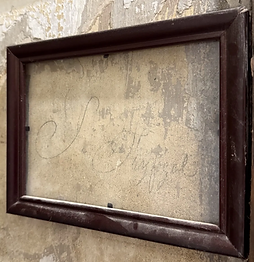top of page
Lower Hallway
The Lower Hallway was restored in 2023, find more information about the restoration process here.
This lower hallway was what all guests first saw when they entered the tavern. Imitation marble blocks were hand-painted onto the walls but had faded over time. In 2023, our local artist Emily Coyne recreated the imitation marbling while still preserving a few of the best preserved pieces to showcase how it changed over time.


The image on the left showcases some of the original marbelizing pieces done in 1845. There were very few blocks remaining that had been preserved well enough to see the texture within the art work.
Archaeology Display

In 1975, board members began restoration work to ensure the building could withstand the elements and continue to be an attraction for future generations. This included filling in the dirt floor in the Basement Kitchen with concrete and supporting the building with additional support beams. Prior to doing that, board members took their shovels to the dirt floor and some of the surrounding area of the tavern to see what they could discover. As they were not professionals, not much information could be drawn from the location that the items were found. Some pieces are on display here at Fryfogel Tavern, while others remain in the hands of the Stratford Perth Museum.
Staircases
This set of stairs and the railing attached to them are original to the construction of the building in 1845. They have held up incredibly well and still stand sturdy to allow all our volunteers and visitors to explore the entire building.
These stairs are not original to the building and were replaced to ensure the safety of our visitors.
The stairwell features Sebastian Fryfogel’s signature from 1845, when the building was complete. Over time it became hidden under layers of whitewash. With incredible caution, we removed about 16 layers of whitewash to reveal this piece of history that Sebastian left behind.



Another addition in this stairwell is the mediocre dumbwaiter. Instead of being hoisted by a pulley system, it was simply a hole halfway up the stairs that opened onto the floor of the dining room. Cooks in the kitchen would place the dishes on the floor of the dining room where a server (or even a guest) would pick up the dish off the floor and bring it to the table. This saved the cooks not only from going all the way up the stairs with each dish, but also from the inappropriate pestering that male guests would often give to the female workers.

bottom of page


